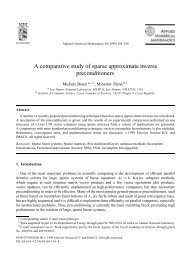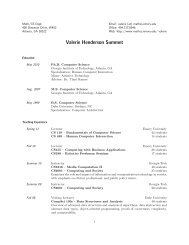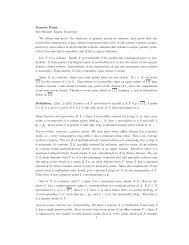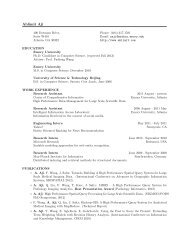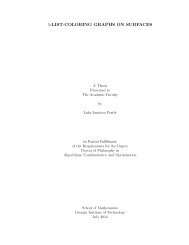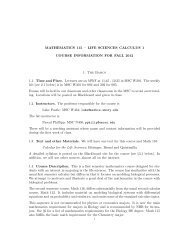Chapter 3 Solution of Linear Systems - Math/CS
Chapter 3 Solution of Linear Systems - Math/CS
Chapter 3 Solution of Linear Systems - Math/CS
You also want an ePaper? Increase the reach of your titles
YUMPU automatically turns print PDFs into web optimized ePapers that Google loves.
80 CHAPTER 3. SOLUTION OF LINEAR SYSTEMS<br />
Given this factorization, and a vector b, we could solve the linear system Ax = b using the<br />
following Matlab statements:<br />
d = P*b;<br />
y = L \ d;<br />
x = U \ y;<br />
These statements could be nested into one line <strong>of</strong> code as:<br />
x = U \ ( L \ (P*b) );<br />
Thus, given a matrix A and vector b we could solve the linear system Ax = b as follows:<br />
[L, U, P] = lu(A);<br />
x = U \ ( L \ (P*b) );<br />
The cost <strong>of</strong> doing this is essentially the same as using the backslash operator. So when would we<br />
prefer to explicitly compute the P A = LU factorization? One situation is when we need to solve<br />
several linear systems with the same coefficient matrix, but many different right hand side vectors.<br />
It is more expensive to compute the P A = LU factorization than it is to use forward and backward<br />
substitution to solve lower and upper triangular systems. Thus if we can compute the factorization<br />
only once, and use it for the various different right hand side vectors, a substantial savings can be<br />
attained. This is illustrated in the following problem, which involves a relatively small linear system.<br />
Problem 3.5.18. Create a script m-file containing the following Matlab statements:<br />
n = 50;<br />
A = rand(n);<br />
tic<br />
for k = 1:n<br />
b = rand(n,1);<br />
x = A\b;<br />
end<br />
toc<br />
tic<br />
[L, U, P] = lu(A);<br />
for k = 1:n<br />
b = rand(n,1);<br />
x = U \ ( L \ (P*b) );<br />
end<br />
toc<br />
Currently the dimension <strong>of</strong> the problem is set to n = 50. Experiment with other values <strong>of</strong> n, such as<br />
n = 100, 150, 200. Comment on your observations.



